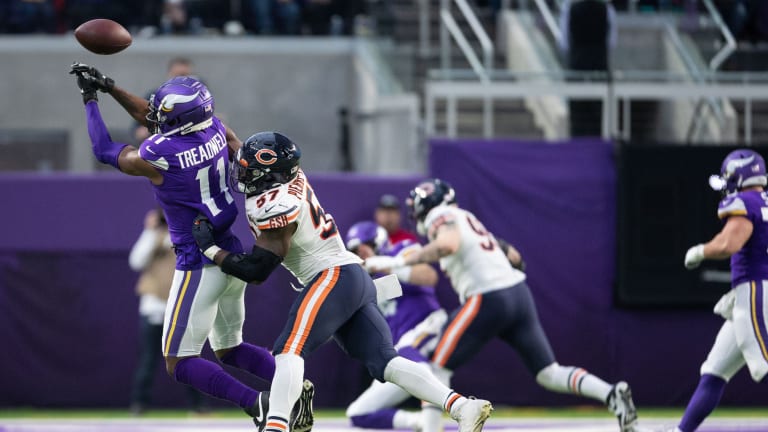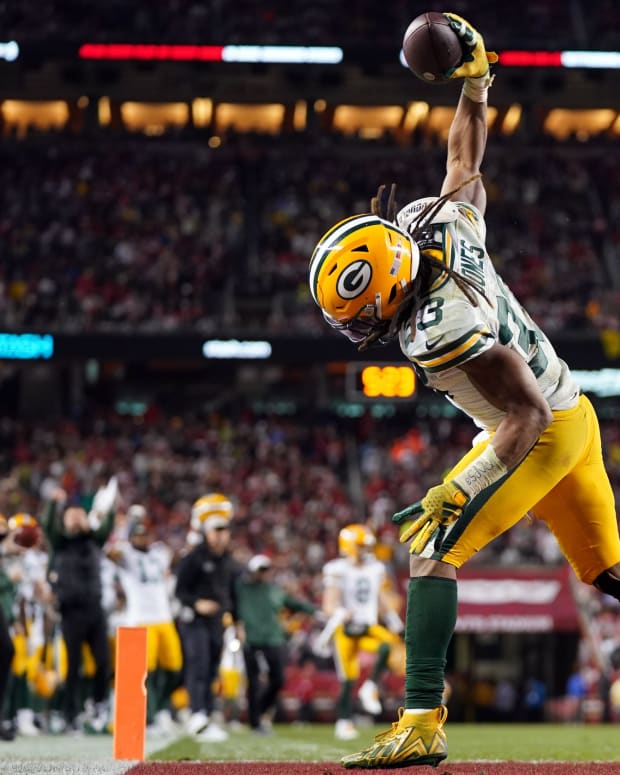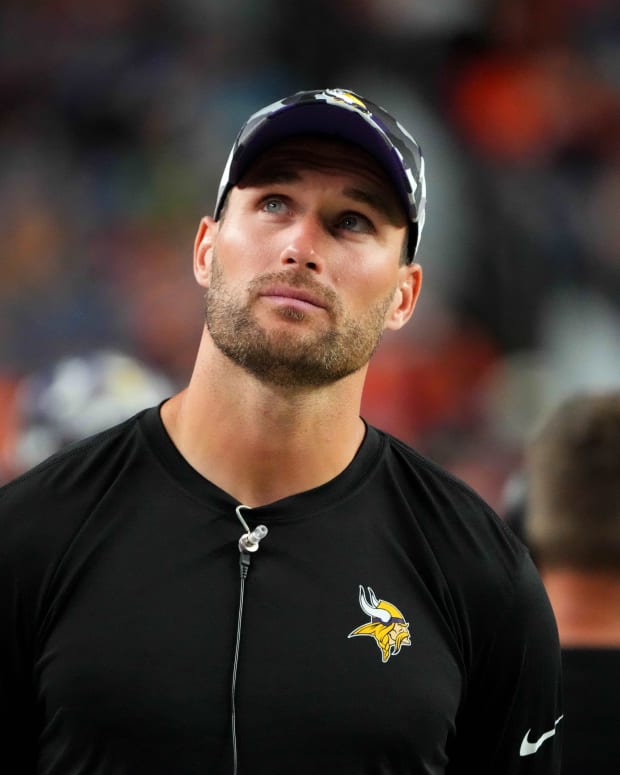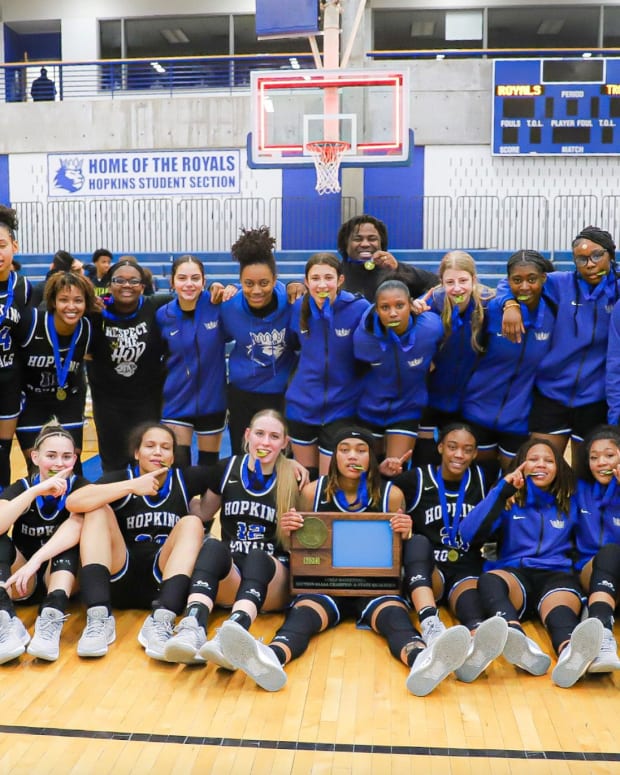
What we can learn about draft strategy from Vikings picks of the past

It’s tax season, so let’s get out all the receipts.
As we approach the NFL Draft, we are going through all the potential angles for the Minnesota Vikings. Should they fill a need at corner? Would a receiver make sense even if it isn’t an immediate opening? More pass rush, anyone? Does anyone trust the quarterback class? Trade down? Trade up? Trade for some star player we never expected?
There are lots of different ways they could go. And think about all the unpredictable things that have happened recently on draft night. On the afternoon of last year’s Round 1, rumors came out that Aaron Rodgers wanted out of Green Bay and that deals could be in the works to move him to San Francisco. There was Laremy Tunsil’s gas mask bong. Johnny Manziel’s text to the Browns owner. Lamar Jackson dropping. The Vikings running out of time, only to eventually pick superstar Kevin Williams. It gets wild.
The best part is the first guesses. Was it a good pick? Everybody makes their case for who won the draft and whether their team nailed it or blew up their future with a huge mistake. All the draft analysts compare their own draft boards to the picks and decide what grade everybody deserved.
It’s all ridiculous, of course.
ESPN’s Mel Kiper gave the Vikings’ 2015 draft a “B” and it turned out to be one of the best by any team of the entire decade. Bart Hubboch of the New York Post gave the 2016 class an “A” and wrote: “Both of the first two picks look like home runs in stud Ole Miss wideout Laquon Treadwell and promising Clemson man-coverage corner Mackensie Alexander. Minnesota definitely is on the rise.”
Narrator: Neither of the first two picks were home runs.
Related: The Vikings can now take the best available player in the draft
This isn’t to make fun of draft grades. Nah, draft grades are great. Who doesn’t want to know what the world thinks of their team’s draft? Who doesn’t want to have an opinion on what just happened? What draft grades also do is give us a baseline for expectation and the thinking behind what teams did on draft night.
We can accurately say that the draft is super random but also look back and figure out if the team made a logical pick or took a pragmatic path or if their ideas were flawed.
In recent years, the Vikings haven’t drafted particularly well. Since 2016, the only hit in the first round has been Justin Jefferson (jury still out on Christian Darrisaw). The second round has been more friendly with Dalvin Cook, Brian O’Neill, Irv Smith Jr. and Ezra Cleveland being taken, but the third round and beyond — woof.
The draft struggles of 2016-2021 are at the center of why the Vikings are in “competitive rebuild” mode as we speak. If they had found “the next Danielle” or some of the project offensive lineman turned into quality starters, they wouldn’t need to use an abacus to figure out how much cap space they can kick down the road to add Za’Darius Smith or Chris Reed.
Related: Free agents left on the market give Vikings affordable options
Alas, there’s nothing new GM Kwesi Adofo-Mensah can do about the past. But we can look back at what we thought on draft nights from recent years and look for clues about how the Vikings can repeat successes and avoid pitfalls.
We can take a lot from 2016. When Laquon Treadwell was picked, there was some debate over his 40 time and whether he would ever have the speed to create separation from defenders. Supporters of the pick said he would be like Anquan Boldin. NFL.com said he was like DeAndre Hopkins.
At the time, that seemed to add up. And the Vikings appeared to need a receiver badly (that was before Adam Thielen emerged). But in hindsight, we can see where the Vikings erred. The website Relative Athletic Scores takes Combine results and produces a percentile of athleticism in which a player lands among his position group. Laquon Treadwell was in the 33rd percentile — meaning, of all receivers to participate in the Combine, 67% of them were better raw athletes than him. Only five receivers since 2000 made the Pro Bowl with Combine scores below the 40th percentile.
Aiming for outliers is always tricky business. Drafting undersized defensive tackles because Aaron Donald worked out isn’t generally playing the percentages. In 2016, the Vikings started their trend of trying to find another Danielle Hunter. In a media session, Rick Spielman mentioned the strategy of trying to match up athletic scores to “clone” players.
The problem, of course, is that Danielle Hunter scored in the 99th percentile, which made him impossible to clone unless you’re Myles Garrett or Mario Williams. Still the Vikings went back to that well year after year, taking Stephen Weatherly in the seventh of 2016, then Jalyn Holmes and Ade Aruna in 2018, DJ Wonnum in 2020 and Janarius Robinson in 2021. All of those players had good athletic scores. None remotely approached Hunter.
We can also question picks at positions that simply are not hard to replace. In 2016, the Vikings landed OK players in Kentrell Brothers and David Morgan in the fifth and sixth round. There’s no harm done by taking special teamers or likely backups in the late rounds but the upside is non-existent. The best-case scenario for a run-stuffing linebacker with 29th percentile athleticism is that he makes the team and only sees the field on kickoffs and punts. Morgan hit the peak of his skill as a plus blocker but the best version of him was still a player the Vikings could have found for $990k on the free agent market.
Yet they continued to repeat this miscue. In 2017, the Vikings selected Ben Gedeon in the fourth. Like Morgan, he maxed out his talent as a run stopper who played 30% of snaps. They traded back in the third round and landed on Alex Mattison, a bruising running back. The value over any replacement No. 2 RB hasn’t been much. They took a long snapper in 2019 — a position where there is always a free agent or 12 available. They picked a low-ceiling quarterback in Nate Stanley.
You might say that these 3rd-7th rounders aren’t a big deal but every pick wasted on a player whose job could be covered on the UDFA market or for hardly any money in free agency is a dart not thrown at the board.
Of course, the Vikings threw plenty of good darts. In 2016, Moritz Boehringer and Jayron Kearse were good ideas. Put the fact that Boehringer had never played at anywhere near the NFL level before and look at his draft status and athletic measures. His Relative Athletic Scores was in the 99th percentile, rivaling Calvin Johnson for the highest score ever. That’s worth a shot. And Kearse was unique because of his height. In the later rounds, taking players who might have something that sets them apart or gives them versatility is a good play. Ifeadi Odenigbo might be a lesser version of that. His lack of height made him less attractive among edge rushers but he ended up being better than a high percentage of late-round picks.
On draft night 2017, the Vikings sat home and watched and thought about how badly they needed Sam Bradford to succeed in 2017 in order to justify trading a first-round pick to the Eagles. That trade is worth remembering when everyone wants to be like the Rams and fire off their first-rounders to get proven players.
The Vikings picked Dalvin Cook. Our first impression was that they needed a successor to Adrian Peterson and they’d landed an absurdly talented prospect with a spotty past. Two things here: 1) Cook has been a premier player at his position over four years and couldn’t have been more of a home run, yet it didn’t make a significant difference in the Vikings’ fate. 2) Alvin Kamara and Aaron Jones were taken much later and became just as good.
Parts 1 and 2 are why there is so much talk of positional value. Eight running backs taken after Cook in the 2017 became good players. He was marvelous in 2020 and the Vikings’ offense was just average. Plus, when you draft a running back and he’s good, you are essentially obligated to pay him at the end of his rookie deal, which the Vikings did.
The positional value monster came back to bite them again in 2019. The Vikings picked a center and tight end with their first two selections. In order to get bang for buck at those spots, the picks have to be stars. Center is the lowest paid non-specialist position and there are only a handful of tight ends who impact the game with explosive plays. Smith Jr. still has a chance to do that but we saw last season that fifth-rounder Tyler Conklin, with a few years of development, was able to produce 61 catches and 593 yards. Players like AJ Brown and DK Metcalf were available when the Vikings picked Smith Jr. His ceiling isn’t close to theirs based entirely on big-play possibilities.
Sometimes the Vikings picked the right value play and it didn’t work out: See Mike Hughes and Jeff Gladney. Neither was a bad athlete. Both had high grades. Coincidentally both picks were scrutinized for different reasons but things outside of their performance got in the way.
We wondered if the Vikings needed a cornerback when they picked Hughes. Why weren’t they going for win-now? Fill a need! Draft Will Hernandez! When Hughes had a pick-six in his first game, Mike Zimmer snarked about those criticizing the pick. Hughes tore his ACL shortly after that and then had a neck injury the following year. The Vikings remain short at the cornerback position following the exits of Trae Waynes and Xavier Rhodes.
Gladney wasn’t named Antonie Winfield Jr., so his selection was questioned. Winfield Jr. dominated at Minnesota and fans were looking for the next Tyrann Mathieu. They turned out to be right about Winfield Jr. but Gladney showed flashes early in his career. However, an indictment on domestic violence charges caused the team to release him.
Had Hughes and Gladney worked out, the defense would look quite a bit different right now.
Sometimes the right positional value pick turned out tremendously well for the Vikings. Brian O’Neill ranked in the 96th percentile RAT but was knocked for his lack of girth. Picking him in the back end of the second round was a swing for the fences that he’d add weight and maintain his athletic prowess. That came to fruition.
Forced or not, Justin Jefferson was the player who could add the most value to the offense in 2020. His production and athleticism suggested that he could become a franchise-changing player and that’s exactly what happened. The combination of elite athleticism, elite production and a player slipping through the cracks has often been a winner in the draft.
Last year might be instructive too. Passing on a quarterback to take a player at a position of immediate need is taking a lottery ticket and lighting it on fire. Christian Darrisaw might end up being the world’s best left tackle and it won’t matter if the Vikings do not have the right answer at quarterback. If the Vikings picked Mac Jones, things would be very different today.
That’s not to argue that he would be the next Fran Tarkenton, only to say that the whole world believed Jones wasn’t mobile and athletic enough (72nd percentile, by the way) and he instantly proved to be the most NFL-ready prospect. Sometimes it’s just worth taking a shot at a quarterback, even if you’re not sure he can be “the guy.” Hitting on a good QB on a rookie contract is vastly more valuable than almost any other position’s great players.
Does that apply to this year? Who knows.
The biggest takeaway from our run through memory lane of past drafts is that drafting is hard. The Vikings saw the whole spectrum of reasons that picks did or didn’t work out. Now it’s the goal of the Adofo-Mensah regime to tip the scales slightly more in their favor. They can start by avoiding some of the logical errors of the past regime — and then hope for better luck.







